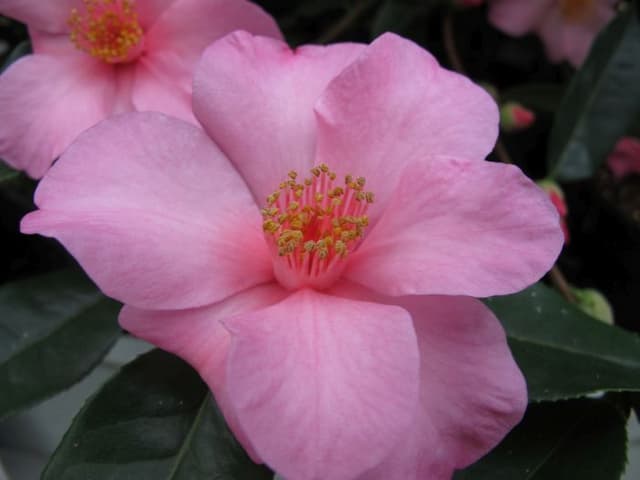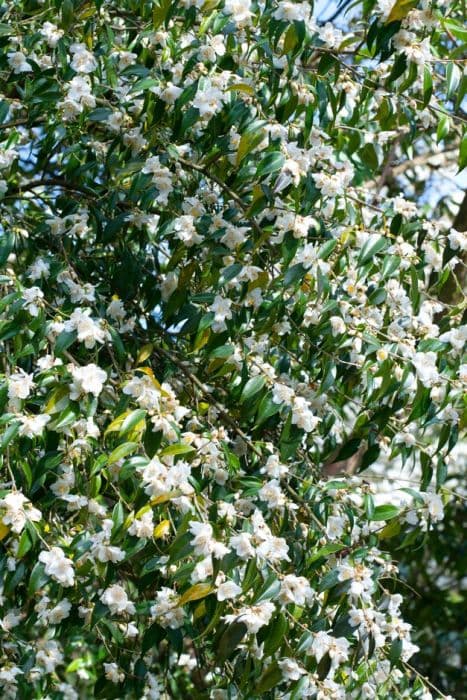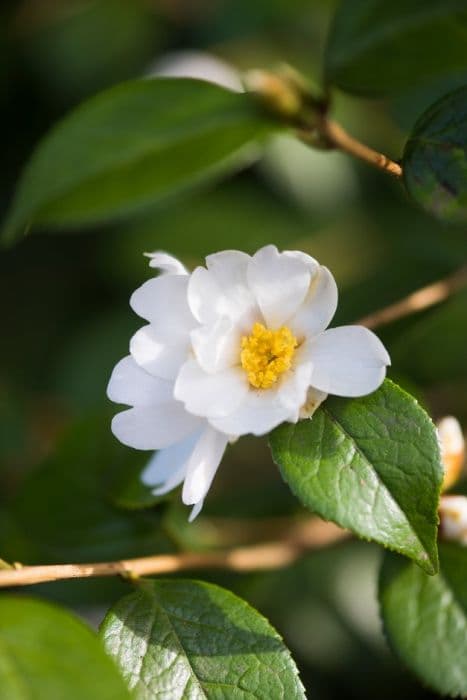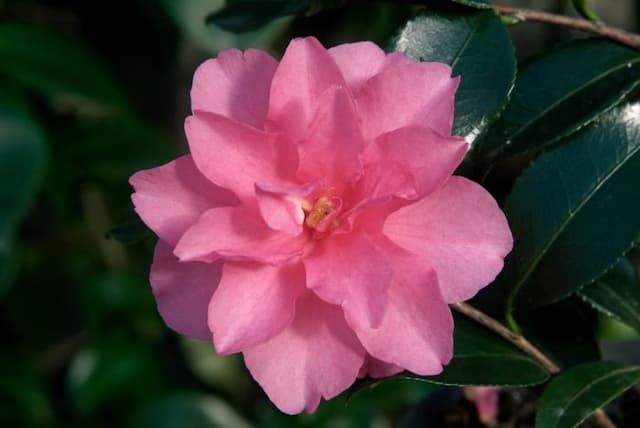Japanese Camellia Camellia japonica 'Grand Slam'

ABOUT
Camellia japonica 'Grand Slam' is a visually striking ornamental plant known for its large, vibrant blooms. The magnificent flowers of 'Grand Slam' are typically a deep, intense red, which can add a dramatic flair to any garden setting. Each bloom is full and lush, featuring a multitude of layered petals that create a peony-like effect. These petals have a waxy, smooth texture, contributing to their luxurious appearance. The foliage of 'Grand Slam' is equally appealing, with glossy, dark green leaves that provide a lustrous backdrop to the showy flowers. The leaves are leathery to the touch, and their edges are finely serrated. Together, the dark foliage and red flowers create a classic color combination that draws the eye and makes a strong visual statement. Spring is usually the peak blooming season for the 'Grand Slam,' when the plant is covered in its alluring flowers. The blossoms typically last for a few weeks, providing a long-lasting display of color and elegance. Overall, Camellia japonica 'Grand Slam' is considered a jewel in the garden, celebrated for its striking appearance and the beauty it brings to the landscape.
About this plant
 Names
NamesFamily
Theaceae.
Synonyms
Japanese Camellia, Rose of Winter, Common Camellia, Japonica.
Common names
Camellia japonica 'Grand Slam'.
 Toxicity
ToxicityTo humans
The Japanese Camellia is generally considered non-toxic to humans. There is no well-documented toxicity for ingestion of this plant. However, as with many plants, individual allergies or sensitivities can exist, so it is always wise to be cautious and avoid ingesting plant material that is not commonly used for food.
To pets
The Japanese Camellia is not considered toxic to pets. There is no significant evidence to suggest that the ingestion of this plant poses a serious risk to animals. Nevertheless, individual pets may react differently and may experience mild gastrointestinal upset if they ingest large quantities of the plant, though this is not common. Always monitor your pets around plants and contact your veterinarian if you observe unusual behavior or symptoms after ingestion.
 Characteristics
CharacteristicsLife cycle
Perennials
Foliage type
Evergreen
Color of leaves
Green
Flower color
Red
Height
6-10 feet (1.8-3 meters)
Spread
5-7 feet (1.5-2.1 meters)
Plant type
Shrub
Hardiness zones
7
Native area
Japan
Benefits
 General Benefits
General Benefits- Aesthetic Appeal: The Camellia japonica 'Grand Slam', commonly known as the Japanese camellia, features large, showy flowers that enhance the visual appeal of gardens and landscapes.
- Year-Round Interest: With glossy, evergreen leaves, the Japanese camellia provides year-round interest even when not in bloom.
- Versatility: This plant can be used in various garden designs, including formal, cottage, and woodland gardens.
- Privacy Screening: Its dense foliage can be used to create privacy screens or hedges in the garden.
- Low Maintenance: Once established, the Japanese camellia requires minimal care, making it an easy choice for gardeners of all skill levels.
- Cold Tolerance: This cultivar is relatively hardy and can tolerate cooler temperatures, making it suitable for a range of climates.
- Wildlife Habitat: Camellias can provide shelter and food for birds and other wildlife in the garden.
 Medical Properties
Medical PropertiesThis plant is not used for medical purposes.
 Air-purifying Qualities
Air-purifying QualitiesThis plant is not specifically known for air purifying qualities.
 Other Uses
Other Uses- Camellia seed oil, extracted from the seeds of Camellia japonica 'Grand Slam', can be used as a natural lubricant for tools and machinery, being a biodegradable and environmentally friendly alternative to synthetic oils.
- Dye extraction is possible from both the petals and leaves of the Camellia japonica 'Grand Slam', which can provide shades of pink or green for fabric dyeing in small-scale or artisanal textile projects.
- The wood of Camellia japonica 'Grand Slam' is dense and can be carved into small objects like jewelry, buttons, or intricate ornaments, valued for its fine grain and smooth finish after polishing.
- Leaves from the Camellia japonica 'Grand Slam' can be used in the crafting of compost or mulch, contributing valuable nutrients to garden soil as they decompose.
- In floral art, the strong, glossy, and evergreen leaves of Camellia japonica 'Grand Slam' are used as a backdrop in bouquets and arrangements, providing contrast and supporting the structure of the design.
- Petals of the Camellia japonica 'Grand Slam' can be scattered in ceremonial pathways or used to float in bowls of water for decorative purposes at events and weddings.
- The Camellia japonica 'Grand Slam' can be grown and shaped into bonsai, combining the artistry of miniature tree cultivation with the beauty of its blooms.
- Pressed flower techniques can be employed to preserve the Camellia japonica 'Grand Slam' flowers, using them in crafts such as bookmark making or in the decoration of picture frames.
- The use of Camellia japonica 'Grand Slam' in photography and painting provides a rich subject matter due to the plant's striking flowers, allowing for studies in color and form.
- Culinary artists sometimes use the non-toxic petals of Camellia japonica 'Grand Slam' as delicate garnishes for desserts and specialty dishes to add a touch of elegance.
Interesting Facts
 Feng Shui
Feng ShuiThe Camellia is not used in Feng Shui practice.
 Zodiac Sign Compitability
Zodiac Sign CompitabilityThe Camellia is not used in astrology practice.
 Plant Symbolism
Plant Symbolism- Adoration: The Camellia flower is often associated with deep adoration and affection, making it perfect to express genuine fondness for someone.
- Perfection: With its perfectly formed petals and rich color, the Camellia represents the ideal or the pursuit of perfection in a relationship or endeavor.
- Longevity and Faithfulness: Camellias are known for their longevity and the ability to bloom for many seasons, symbolizing the enduring nature of love and the faithfulness between partners.
- Refinement: The sophisticated beauty of the Camellia suggests refinement and speaks to a suitor's intentions of honoring someone with respect and deep admiration.
- Pride: Gifting Camellias can indicate pride in the relationship or in the accomplishments of the recipient, often used to celebrate personal successes.
 Water
WaterThe Japanese Camellia 'Grand Slam' requires consistent moisture and should be watered once a week with 1 to 1.5 gallons of water, depending on the size of the plant and the weather conditions. The soil should be kept evenly moist but not soggy; overwatering can lead to root rot. During dry spells or in hot summer months, you may need to water more frequently. It's best to water this plant deeply at the base, avoiding wetting the leaves to prevent fungal diseases. During winter, reduce watering to prevent cold damage, but do not let the soil dry out completely.
 Light
LightJapanese Camellia 'Grand Slam' thrives in partial shade, with protection from the intense afternoon sun. Ideal conditions include dappled sunlight or light shade, which mimics the natural understory environment where these plants are typically found. Morning sun with afternoon shade is perfect to promote healthy growth without causing stress from overexposure to direct sunlight.
 Temperature
TemperatureJapanese Camellia 'Grand Slam' prefers a temperate climate with temperatures ranging between 40 to 85 degrees Fahrenheit. The plant can survive minimum temperatures down to about 20 degrees Fahrenheit but for a short period only. The ideal temperature for optimal growth is between 60 to 75 degrees Fahrenheit. It's important to protect the camellia from extreme cold or heat, as both can lead to damage.
 Pruning
PruningPrune Japanese Camellia 'Grand Slam' to maintain its shape, remove dead or weak branches, and promote vigorous growth. Pruning should be done just after the blooming season ends in spring. Remove any inner branches that are crossing or rubbing against each other to improve air circulation. Cutting back the camellia immediately after flowering allows time for the new growth to mature and bloom in the following season.
 Cleaning
CleaningAs needed
 Soil
SoilCamellia, commonly known as Japanese Camellia, thrives in well-draining, acidic soil with a pH between 5.5 and 6.5. A good mix for potting would be equal parts of peat moss, pine bark, and either perlite or vermiculite to ensure proper moisture retention and drainage. Regularly check the acidity of the soil, as Japanese Camellia prefers a consistent pH environment.
 Repotting
RepottingJapanese Camellia should be repotted every 2 to 3 years. The best time to repot is in late winter or early spring before the plant begins its growth cycle. Use a slightly larger pot each time to accommodate the growing root system, ensuring it has adequate space to develop.
 Humidity & Misting
Humidity & MistingJapanese Camellia flourishes in environments with high humidity, ideally around 50-60%. If grown indoors, consider using a humidity tray or a room humidifier to maintain these levels, as too low humidity can lead to bud drop and leaf problems.
 Suitable locations
Suitable locationsIndoor
Place Japanese Camellia in bright, indirect light, keep soil moist.
Outdoor
Plant in partial shade, shelter from strong winds, mulch root area.
Hardiness zone
7-9 USDA
 Life cycle
Life cycleCamellia japonica 'Grand Slam', commonly known as the Japanese Camellia or Common Camellia, begins its lifecycle when seeds are planted in well-drained, acidic soil in partial shade. The seed germinates and a seedling emerges, developing true leaves and slowly growing into a mature shrub over several years. As an evergreen, it continuously produces glossy, dark-green leaves. Once mature, usually after a few years, the plant produces large, showy red to dark pink flowers typically during late winter to spring. After pollination, often by insects, it develops dry capsules containing seeds, completing the reproductive cycle. Throughout its life, which can span over 100 years if conditions are favorable, the Japanese Camellia requires consistent moisture and protection from extreme temperatures to thrive.
 Propogation
PropogationPropogation time
Spring-Early Summer
Camellia japonica 'Grand Slam', commonly known as the Japanese camellia, is commonly propagated by semi-hardwood cuttings. This is typically done in late summer when the new growth has matured enough to be semi-woody but still retains flexibility. To propagate by cuttings, a gardener selects healthy semi-hardwood stems that are about 4 to 6 inches long (approximately 10 to 15 centimeters) and removes the leaves from the lower half of the cutting. The cut end is then dipped in rooting hormone to stimulate root growth and placed in a moist potting mix or a propagation medium. The cuttings are kept under high humidity and indirect light until roots develop, which can take several weeks to a few months. To enhance the success rate, maintaining a consistent temperature between 70 to 75 degrees Fahrenheit (around 21 to 24 degrees Celsius) is beneficial. Once rooted, the cuttings can be transplanted to individual containers and eventually to their permanent outdoor location.









